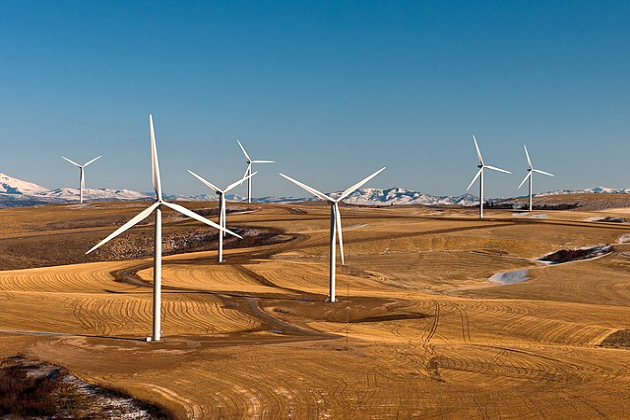Is the UK's energy storage growing fast enough?
The Conversation
01 May 2025, 15:28 GMT+10

Britain's booming green energy generation has a costly side-effect: the national electricity system operator has had to compensate wind turbine operators that could have produced more clean electricity than the grid could take.
The cost of paying windfarms to temporarily switch off rose significantly in early 2025, surpassing Pound 250 million in the first two months of the year. This figure not only includes these "constraint payments" to windfarm operators, but also payments to gas power plants to switch on and meet demand in the south of England that could theoretically be met by wind energy.
Wind power is often generated in remote areas like the Scottish Highlands, where there is low electricity demand. To transmit this power over long distances to areas of higher demand (mostly in the south of England) requires power lines, but these have transmission limits and there are not enough of them.
Britain will only make effective use of its energy potential if grid-scale energy storage keeps pace with the expansion of new windfarms and other forms of intermittent renewable energy, such as solar.
Large-scale battery systems, pumped hydro and other storage methods could capture the excess energy injected by windfarms on windy days and release it when needed. But are these energy storage options arriving quickly enough?
Most British consumers will not see a significant change in how they use electricity with the introduction of planned storage installations, other than fewer blips in power quality, such as flickering or dimming lights.
You might spot these new energy storage facilities in rows of what look like shipping containers but are actually batteries. And the national grid (which serves England, Wales and Scotland - Northern Ireland has a separate electricity network) will be more capable of responding quickly to even minor variations in electricity supply and demand, meaning fewer headlines about curtailed windfarms.
The UK government is aiming to build up to 27 gigawatts of battery storage by 2030 (in 2023, battery capacity was estimated to be around 5 gigawatts). There are applications totalling 59 gigawatts of battery storage in the connections queue for 2030.
Some of these are speculative - introduced to secure connection slots and permissions, with the intention of selling the rights on. These connections will not necessarily be built, yet contribute to long delays in approvals.
As a result, the energy regulator Ofgem has been working with network operators to reform the connections queue. This includes new rules and more coordination between grid operators and project developers, as well as incentives (such as lower connection charges) to encourage battery developers to ensure their output can be adjusted to accommodate network constraints when necessary.
Having substantial grid-scale energy storage could help stabilise electricity prices, which might give households lower and less volatile bills. It would also reduce the need to fire up gas generators during supply lulls, lowering the influence of expensive imported gas on electricity prices.
Storing excess renewable energy involves a range of technologies. Short-duration storage options such as batteries can supply energy ranging from seconds to a few hours. Long-duration storage, such as pumped hydro, can supply energy for several hours, days or more.
Pumped hydro is the oldest long-duration storage technology. It involves storing vast amounts of energy by pumping water to a higher reservoir when electricity is plentiful, and releasing it to a lower reservoir through a turbine when needed. Dinorwig in north Wales and Cruachan in western Scotland are capable of storing 9 and 7 gigawatt-hours of energy, respectively.
Major expansions are planned, such as the new pumped hydro storage scheme Coire Glas in Scotland. Expected to be completed around 2030-31, it is designed to store 30 gigawatt-hours, adding vast reserves of energy to the grid.
Britain's largest grid-scale battery installation, the Minety battery storage project completed in 2022 in Wiltshire, southern England, is capable of absorbing or delivering 150 megawatts - roughly equivalent to the power demand of 450,000 UK households.
While Britain is making progress with its storage infrastructure, other countries are scaling up rapidly. China has built huge pumped hydro stations and the US is deploying very large grid-scale batteries. Germany, meanwhile, is testing hydrogen storage to absorb the power from its onshore windfarms.
There is a drive by energy companies to develop new forms of long-duration storage. Along with hydrogen, liquidair storage is capable of inter-seasonal storage. This would allow solar energy collected during the summer to be available for release during the duller autumn and winter months.
In liquid-air plants, excess electricity is used to cool air to a liquid which can then be stored in insulated tanks. When electricity is required, the liquid air is heated and turned back into a gas, which moves a turbine and generates electricity. A 50-megawatt liquid-air plant planned near Manchester is expected to start commercial operation in 2026.
In hydrogen energy storage plants, surplus electricity powers an electrolyser that splits water molecules into hydrogen and oxygen. The hydrogen is stored and, when electricity is needed, fed into a fuel cell or turbine to generate the electricity. An example is the proposed Aldbrough facility in east Yorkshire, which is expected to be in operation by 2030 and will have a storage capacity of 320 gigawatt-hours. This facility will use three repurposed salt caverns originally developed to store natural gas.
Energy storage technology has become a serious business opportunity, with companies investing billions of pounds into building new facilities. The variety of projects in the pipeline suggests the UK will be better able to avoid curtailing wind energy in the future, even accounting for growth in wind power capacity. Paying windfarm operators to switch off may soon be a thing of the past.
Don't have time to read about climate change as much as you'd like?
Get a weekly roundup in your inbox instead. Every Wednesday, The Conversation's environment editor writes Imagine, a short email that goes a little deeper into just one climate issue. Join the 45,000+ readers who've subscribed so far.
 Share
Share
 Tweet
Tweet
 Share
Share
 Flip
Flip
 Email
Email
Watch latest videos
Subscribe and Follow
Get a daily dose of Liverpool Star news through our daily email, its complimentary and keeps you fully up to date with world and business news as well.
News RELEASES
Publish news of your business, community or sports group, personnel appointments, major event and more by submitting a news release to Liverpool Star.
More InformationInternational
SectionSingapore orders Meta to block foreign election posts
SINGAPORE: Singapore has ordered Facebook's parent company, Meta, to block Singaporeans from seeing posts made by three foreigners...
Iowa governor sues Des Moines Register over email dispute
DES MOINES, Iowa: Iowa's governor has launched a lawsuit against the Des Moines Register, seeking to block the newspaper from obtaining...
Ex-Detroit nonprofit executive gets 19 years for $40 million theft
DETROIT, Michigan: A former top official at a major Detroit nonprofit was sentenced this week to 19 years in prison for stealing over...
New Mexico hosts global celebration of native and indigenous cultures
ALBUQUERQUE, New Mexico: Thousands of people are gathering in New Mexico for a big event that celebrates Native American and Indigenous...
San Francisco moves toward “recovery first” drug policy
SAN FRANCISCO, California: San Francisco is taking steps to change how it handles drug use. After Some people say focusing on quitting...
Trump signs order to boost skilled trades, shift from college degrees
WASHINGTON, D.C.: President Donald Trump signed an executive order to expand job training for skilled trades this week, shifting focus...
UK
SectionRWE halts US offshore wind plans amid regulatory uncertainty
FRANKFURT, Germany: German energy giant RWE has paused its offshore wind operations in the United States, citing ongoing regulatory...
Congress MP Pramod Tiwari calls caste census inclusion "victory" for Rahul Gandhi & Mallikarjun Kharge
New Delhi [India], May 1 (ANI): Congress MP Pramod Tiwari on Thursday described the Centre's decision to include caste-based census...
Pentagon chief threatens Iran amid Houthi attacks
Tehran knows very well what the US military is capable of, Pete Hegseth has said US Defense Secretary Pete Hegseth has blamed Iran...
Monks offer prayers to Sarnath Buddha Relic before it commences sacred journey to Vietnam
New Delhi [India], May 1 (ANI): A large gathering of monks, bhikkhunis, diplomats and the Sangha today offered chanting and special...
Is the UK's energy storage growing fast enough?
Britain's booming green energy generation has a costly side-effect: the national electricity system operator has had to compensate...
Chinese youths help revive Turfan studies on ancient Silk Road
An aerial drone photo taken on April 5, 2025 shows a view of the Ya'er Lake Grottoes in the city of Turpan, northwest China's Xinjiang...












